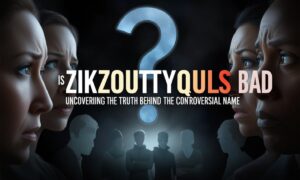
What is Zikzoutyqulsis?
Zikzoutyqulsis is a term that has gained traction within specific fields of study, though it remains relatively obscure in mainstream discussions. It is characterized as an occurrence or phenomenon that exhibits unique properties which can influence its environment in significant ways. The origins of zikzoutyqulsis can be traced back to early theories that sought to explain certain complex behaviors in various systems. As such, it synthesizes principles from disciplines such as biology, physics, and psychology, thereby positioning itself as an interdisciplinary concept.
Typically, zikzoutyqulsis manifests in several forms, each with distinct characteristics. For instance, one could encounter it as a behavioral pattern within social contexts, where it may contribute to group dynamics or individual interactions. Alternatively, zikzoutyqulsis can also emerge in natural environments, exemplified by ecological relationships or phenomena that affect biodiversity. These diverse manifestations highlight the complexity of zikzoutyqulsis and the precise conditions under which it may arise.
Contextually, zikzoutyqulsis is often associated with phenomena that carry implications for safety, health, or ecological stability. In certain scenarios, understanding its characteristics can be crucial in assessing whether it poses risks or benefits to a given system. For instance, recognizing the signs of zikzoutyqulsis in an ecosystem may aid in conservation efforts and inform decision-making processes regarding environmental management. Moreover, within behavioral studies, identifying zikzoutyqulsis-related patterns can have practical applications in fields such as psychology and sociology, helping to decipher complex human behaviors.
The exploration of zikzoutyqulsis serves to deepen our understanding of its various forms and implications, making it essential for researchers and practitioners alike to articulate its significance in relevant discussions.
Potential Risks and Dangers of Zikzoutyqulsis
As the discourse surrounding zikzoutyqulsis progresses, it becomes imperative to assess whether this phenomenon poses any substantial dangers to humans, animals, or the environment. Scientific research and expert analyses play a pivotal role in identifying any potential risks associated with zikzoutyqulsis. This section explores the various dimensions of its impact and evaluates both direct and indirect dangers.
Initial inquiries have indicated that the risks related to zikzoutyqulsis may not be as pervasive as some might believe. For instance, health-related studies have monitored individuals exposed to zikzoutyqulsis, concluding that while certain symptoms emerged, they were often unrelated or coincidental to actual exposure. Furthermore, case studies demonstrate instances where individuals reported adverse effects; however, these instances often revealed underlying conditions or external factors contributing to these health issues, suggesting that zikzoutyqulsis itself may not be the primary culprit.
Environmental consequences are another facet worth considering. While there exist concerns regarding the ecological footprint of zikzoutyqulsis-associated activities, research suggests that regulatory measures have been implemented in many areas to mitigate potential hazards. Discussions among environmental experts underscore that comprehensive risk assessments and vigilant monitoring can significantly reduce risks linked to zikzoutyqulsis operations.
Misconceptions regarding the dangers of zikzoutyqulsis frequently arise from sensationalized media portrayals or anecdotal evidence. It is essential to approach these claims with skepticism and seek clarification through scientific validation. Experts emphasize the need for ongoing research to assess any emerging risks adequately and to update guidelines or protocols as necessary. Thus, while there are discussions surrounding the alarming implications of zikzoutyqulsis, the current consensus leans towards a recognition of the relative safety, provided that necessary precautions are taken. This nuanced understanding is critical for both public perception and policy-making on the topic.

Recognizing Zikzoutyqulsis: Symptoms and Effects
Identifying zikzoutyqulsis can be challenging due to its complex nature and varying symptoms that may manifest differently among individuals. Common observable signs may include both physical and psychological effects. Individuals might experience noticeable changes in their behavior or emotional state, such as increased anxiety, irritability, or mood swings. These psychological symptoms can have ripple effects, impacting social interactions and daily functioning.
Physically, individuals might exhibit symptoms that can range from mild discomfort to more severe manifestations. Symptoms such as headaches, fatigue, and sleep disturbances are frequently reported by those affected by zikzoutyqulsis. Observing these signs may be an initial indicator of potential issues related to this condition. Furthermore, anecdotal experiences from affected individuals often highlight the unpredictability of symptoms and their fluctuating intensity, which can complicate diagnosis and recognition.
Communities might also witness broader societal effects stemming from zikzoutyqulsis. For instance, increased healthcare utilization and the burden on mental health services may arise as individuals seek assistance for the manifestations associated with this condition. The stigma surrounding such psychological symptoms can also deter individuals from seeking help, potentially exacerbating feelings of isolation and distress.
It is essential for family members and friends to be aware of these symptoms to provide support and encourage those affected to seek professional help. Increased awareness and understanding of zikzoutyqulsis can enhance recognition and prompt timely intervention, ultimately improving outcomes for affected individuals. They may benefit from educational resources and support groups that can offer shared experiences and coping strategies.
How to Protect Yourself and Mitigate Dangers of Zikzoutyqulsis
Protecting oneself from the potential dangers associated with zikzoutyqulsis is paramount, given the rising concerns surrounding this condition. To begin with, awareness and education are crucial. Understanding the symptoms and risks can help individuals recognize whether they might be at risk. Regularly consulting reliable sources of information, such as medical journals or health organization websites, is advisable.
Preventative measures should be the first line of defense. Proper hygiene plays a significant role in avoiding potential exposure. Simple practices, such as regular handwashing and using hand sanitizers, can significantly decrease the likelihood of contagion. Furthermore, maintaining a clean environment, particularly where food is prepared or consumed, reduces the risk of transmission.
For individuals who find themselves in high-risk categories, vaccination might be an effective option. Staying informed about available vaccines and their efficacy against zikzoutyqulsis symptoms can be beneficial. Alternatively, consult a healthcare provider regarding other preventive treatments that may be applicable to your specific situation.
If exposure to zikzoutyqulsis seems inevitable, consider developing a management plan. This plan might encompass strategies that include staying well-hydrated, maintaining a balanced diet, and incorporating regular physical activity. Such lifestyle choices can enhance overall wellbeing, which in turn may mitigate the impact of any potential health issues.
In conjunction with these preventative measures, leveraging community resources can also be advantageous. Engaging with local health departments or support groups can provide valuable insights into managing and understanding zikzoutyqulsis risks. These resources often offer educational programs that can bolster individual knowledge and response strategies. By equipping yourself with these tools, you can actively engage in safeguarding your health and well-being.


